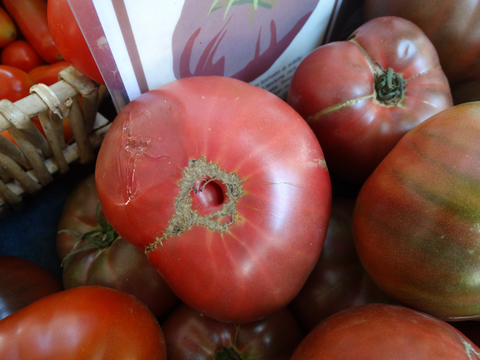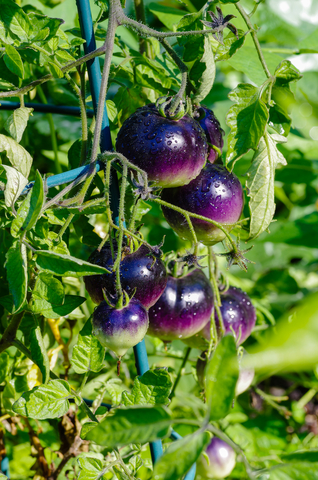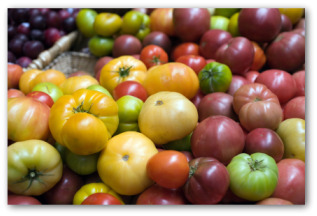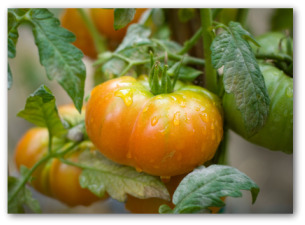Cherokee Purple Tomato, Indigo Rose Purple Tomato, Growing Heirloom Tomatoes,
Here are a few easy tips for growing the Cherokee Purple tomato, and the Indigo Rose tomato in home vegetable gardens.
Learn how to plant, grow, and care for these heirloom tomato varieties in your garden!
The Cherokee is a cultivar heirloom plant variety noted for its great tomato flavor; just the right amount of sweetness, and unique dusky red/deep purple color.
The Indigo Rose is a truly purple tomato, that was recently developed at Oregon State University.
The Cherokee Purple tomato was one of the first known dark colored tomato groups.
The eye-pleasing and mouth-watering Cherokee purple is beefsteak-shaped with green shoulders and its unusual outside coloring carries though to the delectable flesh inside.
About Cherokee Tomatoes
The indeterminate vine plant grows to a height of nine feet to support the heavy-weight one-pound fruit.
In 80 days to harvest, you can be taking a huge bite out of its juicy, dense texture.
An indeterminate tomato plant grows and produces blossoms and fruits until killed by external factors such as frost.
Indeterminate plants produce fruit during the entire growing season, whereas determinate tomatoes are most productive in a larger, single harvest.
As the story goes, the Cherokee purple tomato was given to early settlers of the United States from the Native American Cherokees.
You will be tickled pink to find on examining the fruit that it has a purple hue.
Seeds from the heirloom Cherokee purple were sent by collectors to two major seed companies and each company elected to carry the cultivar, which makes them widely available to the home gardener today.
These heirloom tomatoes are appealing with amateur and professional breeders alike because the vegetables are easy to save seeds from and the plants are easily grown.
Download Free Garden Planning Worksheets, Garden Diary, Zone Chart, Or Planting Guide
Indigo Rose Purple Tomato
The "Indigo Rose" is the first truly purple tomato to be developed. It came about through a program at Oregon State University that was attempting to breed tomato varieties with high levels of antioxidants.
According to a professor in the Oregon State horticulture department, the Indigo Rose tomato is the first improved tomato variety in the world that has anthocyanins (a type of antioxidant) in its fruit.
The seeds are available through various mail order seed companies, including Territorial Seed Company.
Growing Heirloom Tomatoes in the Garden
- Sow tomato seeds such as Cheorkee Purple indoors 8-10 weeks before planting time (one-two weeks after last frost date) to have seedlings ready to transplant into the ground.
- Or purchase tomato seedlings a week or two before planting time.
- Use covers to protect tomatoes from cold nights or unexpected frosts.
Planting Tomatoes
*Plant tomatoes in a location that receives full sun.
*Enrich garden or container soil with compost and/or other fertilizer as growing tomatoes prefer rich soil, well-aerated soil with a pH of 6 to 6.5.
*Soil should be well-drained.
*Tomato plants need at least 3 feet of space in each direction in order to thrive.
*Water tomato plants regularly. One inch of water per week is recommended, with an additional half-inch during very hot dry weather.
*If the soil is dry an inch or two below the surface, it is time to water again.
*Feed tomato plants with liquid fertilizer according to directions on container for best results.
Insect & Disease Control for Growing Cherokee Purple Tomato Plants
- Pests such as thrips can transmit viral diseases to tomato plants.
- Affected plants may show signs such as mottled, splotchy, yellow and light green mosaic patterns.
- Foliage may be curled or crinkled.
- Prevention is the only solution as there is no cure for plant viruses.
- Healthy tomato plants are much more resistant to tomato diseases than weak or undernourished plants.
- Treat insect infestations as soon as possible because insects carrying a mosaic virus can be deadly to tomato plants.
The Cherokee purple tomato is known to have built up a good resistance to Fusarium Wilt and Septoria leaf spot.
Tomato Cage Benefits
You can wrap your tomato cages in row-cover material to protect the plants from insect feeding in their early growth stages.
By the time you remove the protective coverings, the plants will be large enough to be more resistant.
Grow-bags, which are clear plastic vented sleeves, work as well over the cages and its use can double your tomato production.
Problems with soil borne fungal diseases like early blight can be counteracted by trellising your tomatoes.
This way the plants have less contact with the soil and better air circulation.
Make a trellis by stretching a double course of concrete reinforcing wire between sturdy posts.
The wire mesh extends 5 feet above the ground, which gives the plants plenty of room to grow.
How to Make Sun-dried Tomatoes
- In a hot, dry climate, you can sun-dry tomatoes outside.
- Slice them in half and spread the halves out on screening.
- Tent cheesecloth over the tomatoes for protection against insects that want a taste of the Cherokee purple tomato too!
- On cool nights, you may want to bring them indoors.
- The tasty veggies will dry in a day or so.
The Cherokee plants hold up well to plant diseases and mild drought, producing beautifully colored fruit that varies in hues of pinkish/purple.
The Cherokee Purple tomato is sure to be one of your favorite varieties ever grown in the vegetable garden!
You Might Also like to Read:






